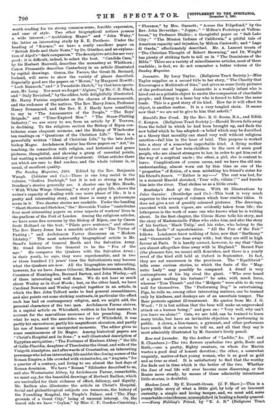The Sunday Magazine, 1891. Edited by the Rev. Benjamin Waugh.
(Isbister and Co.)—There is one long serial in the volume, " Godiva Durleigh," but it is not so strong as Sarah Dondney's stories generally are. A shorter one by Mrs. Meade, " With White Wings Gleaming," a story of gipsy life, shows the writer's capacity of dealing with one more phase of life ; it is a pretty and interesting story, and there is many a picturesque scene in it. Two shorter stories are readable. Under the heading " Short Stories and Sketches," the " Riverside Visitor " contributes four most interesting papers on some aspects of workers' lives in the purlieus of the Port of London. Among the religious articles, we have some fine sermons by the Bishop of Ripon, one by Canon Scott Holland on the text, "Pilate gave sentence," and others. The Rev. Harry Jones has a sensible article on "The Virtue of Fasting ; " and Archdeacon Farrar discourses on " Modern Idolatry." The most noteworthy biographical article is Mr. Stead's history of General Booth and the Salvation Army. Mr. Stead declares the General to be the " Fox of the age." He compares the Quakers with the Salvation Army ; in their youth, lie says, they were reprehensible, and in two or three hundred (!) years' time the Salvationists may become what the Quakers are now. All the biographies are interesting, however, for we have James Gilmour, Madame Schumann, Selina, Countess of Huntingdon, Bernard Barton, and John Wesley,—all of them interesting' and well done. We do not hear as much about Wesley as in Good Words ,• but, on the other hand, we have Cardinal Newman and Wesley coupled together in an article, in which the Rev. John Telford seeks to find general resemblances, and also points out some striking contrasts, in particular the effect each has had on contemporary religion, and, we might add, the personal characters of the two men. Archdeacon Farrar strives, in a capital article on Whitefield, written in his best manner, to account for the marvellous successes of his preaching. From what he says, and the anecdotes we have of Whitefield, it was partly his earnestness, partly his magnificent elocution, and partly his use of humour at unexpected moments. The editor gives us some reminiscences of Dr. Magee. Among historical papers are " Christ's Hospital and its Sons ;" a well-illustrated description of Egyptian antiquities ; "The Fortunes of Hexham Abbey ;" the life of Galla-Placidia, daughter of Theodosius the Great, and wife of the Visigoth Ataulphus, and afterwards of Constantin, an interesting personage who led an interesting life amidst the closing scenes of the Roman Empire, a life crowded with vicissitudes, an " Augusta " for a quarter of a century, and living to see almost the last days of Roman dominion. We have " Roman " Silchester described to us, and also Westminster Abbey, by Archdeacon Farrar, remarkable, we must say, for the beautiful drawings of Herbert Railton, which are unrivalled for their richness of effect, delicacy, and dignity. Mr. Railton also,, illustrates the article on Christ's Hospital. Social and philanthropical subjects are numerous, the history of the Foundling Hospital, the People's Palace, and " The Play- grounds of a Great City," being of unusual 'interest. On the travel side we hive " Ceylon," by Miss C. F. Gordon-Cumming,
" Florence," by Mrs. Garnett; "Across the Folgefond," by the Rev. John Beveridge ; " Toppa; " "Milton's Footsteps at Vallom- brosa," by Professor Blaikie ; a thoughtful paper on " Salt Lake City ; " " The Mission Indians of California," a pitiful tale of American rapacity and injustice, by Milton Cariswell ; and " Lego di Garda," affectionately described. Mr. A. Lamont treats of " The Christian Thought of Robert Browning," and Dr. Wright has plenty of striking facts to tell us in " The Dominions of the Bible." There are a variety of miscellaneous articles, most of them readable ; in fact, we do not remember a better volume of the Sunday Magazine.


















































 Previous page
Previous page